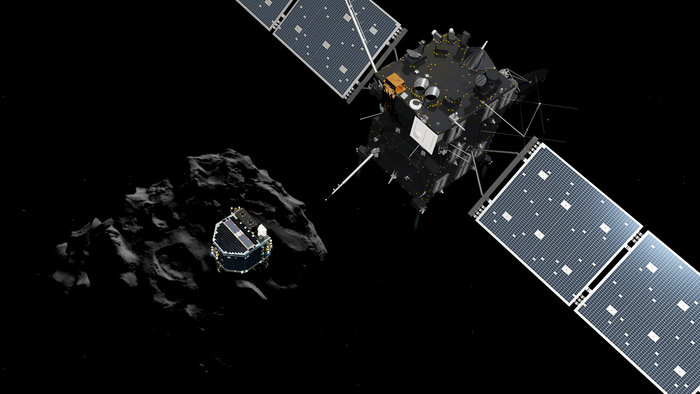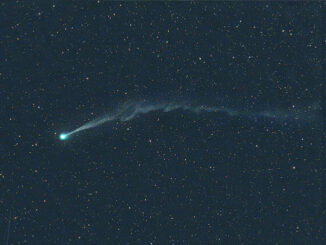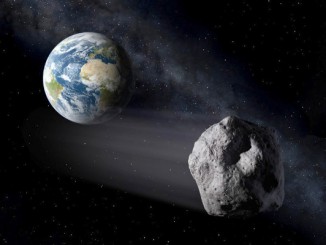STORY WRITTEN FOR CBS NEWS “SPACE PLACE” & USED WITH PERMISSION
Trapped in a forbidding jumble of sun-blocking cliffs and rocky debris, the Philae comet lander, its batteries nearly depleted, somehow managed to contact the Rosetta mothership Friday in true cliffhanger fashion, relaying stored science data back to Earth and receiving commands to turn in place in a last-ditch bid to bring a larger set of solar cells into the meager sunlight.
But a few moments after the pirouette, battery voltage suddenly plummeted and engineers said the end was near. Trapped between a rock and a dark place beyond its ability to survive, Philae dutifully sent back stored data and even made fresh measurements until finally, just after 7:30 p.m. (EST-5), contact was finally lost.
“Link is intermittent,” the European Space Agency tweeted. A few moments later: “The @Philae2014 Lander has switched to stand by due to low power. All instruments off.” ESA followed with a tweet saying the lander was “now sending only housekeeping data at very low rate. All instruments are off.”

Stephan Ulamec, the Philae lander operations manager, said he was thrilled with the spacecraft’s performance. As Philae entered “idle mode,” sending the occasional data packet and final bits of housekeeping telemetry, Ulamec marveled “we can even watch it falling asleep.”
A few minutes later, ESA tweeted: “Loss of signal. No more comm with @Philae2014. All science data from First Science Sequence successfully downloaded.”
It was not immediately clear whether contact was lost because Philae’s battery power dropped below the 21.5 volts needed for normal operation or because Rosetta passed out of view in its orbit around Comet 67P/Churyumov-Gerasimenko.
Either way, stranded in the cold shade of comet cliffs more than 310 million miles from Earth, the 220-pound Philae presumably began slipping into the equivalent of an electronic coma as its battery power steadily draining away.
“Congratulations to the amazing work by the Rosetta/Philae/ESA team,” @BadAstronomer tweeted. “You had an entire planet cheering on a small robot 500 million km away.”
More than any space mission in recent memory, Rosetta’s encounter with 67P/Churyumov-Gerasimenko and Philae’s wild, bouncing touchdown have played out in public on the internet with Twitter capturing the thoughts of many during the lander’s apparently final moments.
Now Philae down to sleep
We pray a sunbeam soon to sweep
And if the hibernation break
We have more science yet to make— A Scanner Snarkly (@BadPhysics) November 14, 2014
“…this is why we feel emotions for little @Philae2014 — it may be nuts, bolts, aluminum and circuits, but it represents us. And science,” wrote @astroengine.
“Sleep well, @Philae2014! Thank you for the images and data. Come back to us when panels are warmed up (hopefully soon!),” said @spacewriter.
Tweeted @BBCPallab: “This death scene by #Philae2014 is almost Shakespearean.”
But reports of Philae’s demise may be premature. While engineers were not particularly optimistic, the lander’s final maneuver should have brought a larger set of solar cells into the limited light of the sun. It might possibly be just enough to revive the hardy spacecraft when Comet 67P/Churyumov-Gerasimenko moves closer to the sun next year and the light falling on the solar cells intensifies.
“So there is some hope that at some stage when we’re closer to the sun that Philae wakes up again and talks to us,” Ulamec said earlier. “But we need to be very lucky that this happens.”
Regardless of the long-term outlook, engineers at the European Space Operations Center were clearly thrilled the lander managed to send home a final set of science data, possibly including the results of an attempt to drill into the crust of the nucleus to collect pristine material for analysis.

Asked how he felt about the mission, Ulamec said “satisfied, I have to say.”
“Of course, it’s a little bit sad to see the power voltage curve going down,” he said. “But I’m very happy. … We lived longer than we could expect in the conditions we had.”
He said the science teams had a wealth of data to study from the observations Philae was able to complete and “they should be really happy” with “a lot of data. From what I’ve seen, it looks pretty good.”
Philae’s wild ride began early Wednesday when Rosetta released it for a seven-hour descent to the surface of 67P/Churyumov-Gerasimenko. The lander was equipped with harpoons and ice screws to anchor itself to the nucleus at the moment of touchdown, but the systems failed to operate and Philae bounced back up into space, reaching an altitude of more than 3,000 feet before coming back down again two hours later.
The lander then bounced away again, finally coming to rest more than half a mile from its original touchdown point. Or so the telemetry indicates. Engineers do not yet know precisely where the spacecraft ended up, whether the initial two-hour bounce was mostly vertical and how that played in with the comet’s 12.4-hour rotation.
Wherever it ended up, frames from a panorama taken after it came to rest revealed nearby cliffs and a chaotic jumble of dark rock-like debris casting long shadows and allowing only minimal sunlight to reach Philae’s solar cells.
“We are not toppled over,” Valentina Lommatsch said from the lander control center. “It looks like we’re kind of surrounded by rocks. … But pictures show all three legs on the ground, and I can confirm from the solar data we have not moved at all since the first set of panorama images after the third landing. So we are on the ground, we just have really (been) unlucky in a corner surrounded by rocks.”
Philae was launched with 50 to 60 hours of charge in its primary and secondary batteries. By Friday morning, most of that was depleted.
In the lander’s original orientation sunlight reached the solar panels during a roughly 90-minute period each 12.4-hour “day.” For most of that time, less than 1 watt is available, but power output climbs to 3 or 4 watts for about 20 minutes.
“The lander needs 5.1 watts to boot, so we have to at least get that,” Lommatsch said. “After we have that, in order to charge the batteries we have to heat it up to zero degrees Celsius. In the simulations that we’ve run, that would mean that we’d need about 50 to 60 watt-hours a day in order to reach zero degrees and still have some of the daylight left to charge the battery. So it doesn’t look that great.”
But Lommatsch said as 67P/Churyumov-Gerasimenko moves closer to the sun and warms up, the amount of sunlight hitting the spacecraft will intensify enough to possibly rouse the lander from its slumber.
But it would take a considerable amount of luck. Rosetta would need go be within line of sight and the lander would need enough power to drive is computer and radio gear.
“Having a link would need additional power again, so we’d have to have something in the battery in order to have a link or be extremely lucky that Rosetta is looking for us in the moment that sunlight reaches the solar panels,” Lommatsch said.
While “it looks a bit bad,” she said, “we can only hope that as we approach the sun, maybe in August if we don’t have too much dust or a huge coma blocking the sun, perhaps there would be a chance that at some point we could come back and at least see how the lander’s doing. “So cross your fingers, or press your thumbs if you’re German, perhaps we’ll hear something from the lander again.”




